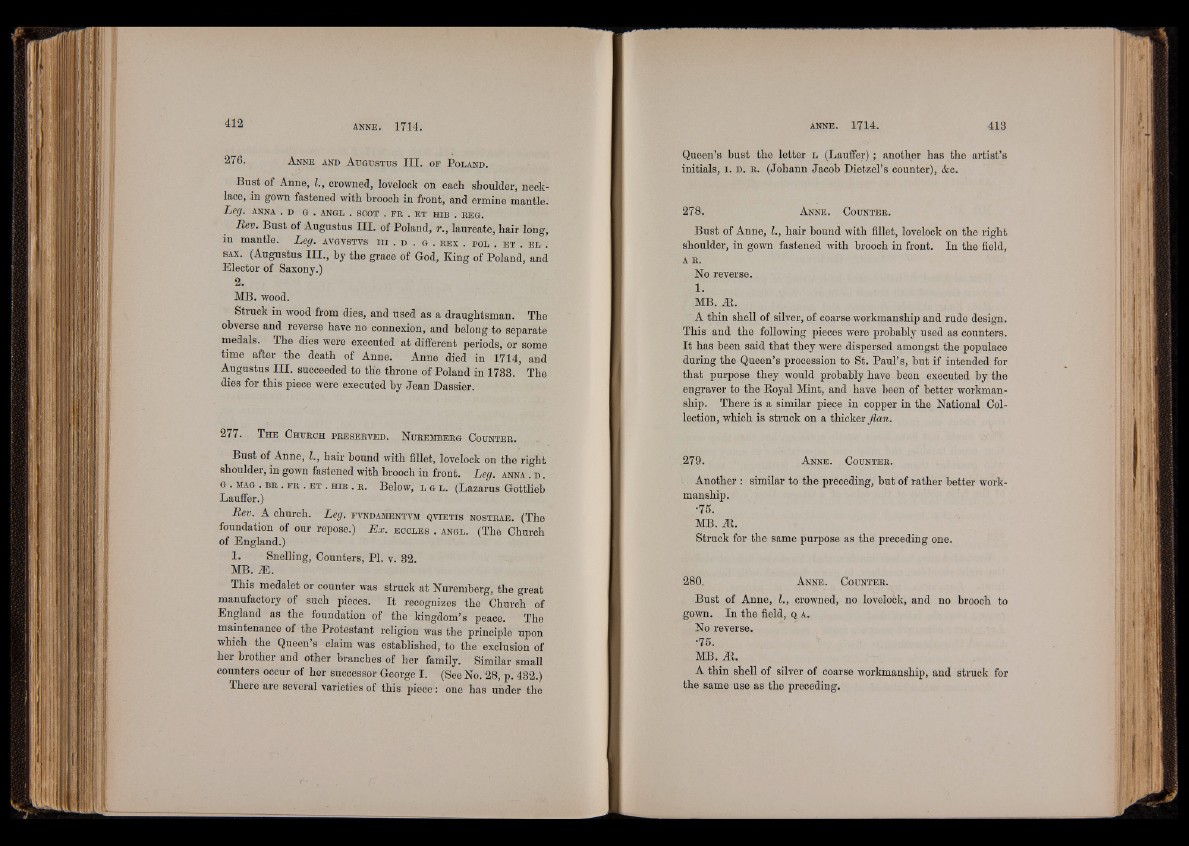
Bust of Anne, I., crowned, lovelock on each shoulder, necklace,
in gown fastened with brooch in front, and ermine mantle.
Leg. ANNA . D G . ANGL . SCOT . FB . ET HIB . EEG.
Rev. Bust of Augustus III. of Poland, r., laureate, hair long,
in mantle. Leg. avgvstvs i i i . d . g . e e x . p o l . e t . e l .
sax. (Augustus III., by the grace of God, King of Poland, and
Elector of Saxony.)
2.
MB. wood.
Struck in wood from dies, and used as a draughtsman. The
obverse and reverse have no connexion, and belong to separate
medals. The dies were executed at different periods, or some
time after the death of Anne. Anne died in 1714, and
Augustus III. succeeded to the throne of Poland in 1733. The
dies for this piece were executed by Jean Dassier.
277. T h e C h u e c h p b e s e e v e d . N u b em b e b g C o u n t e e .
Bust of Anne, I., hair bound with fillet, lovelock on the right
shoulder, in gown fastened with brooch in front. Leg. anna . d .
G . mag . b e . f e . e t . h ib . e . Below, l g l . (Lazarus Gottlieb
Lauffer.)
Rev. A church. Leg. fv n d am en tvm q v ie t is n o s t e a e . (The
foundation of our repose.) Ex. e c c l e s . a n g l . (The Church
of England.)
1. Snelling, Counters, PI. v. 32.
MB. Æ.
This medalet or counter was struck at Nuremberg, the great
manufactory of such pieces. It recognizes the Church of
England as the foundation of the kingdom’s peace. The
maintenance of the Protestant religion was the principle upon
which the Queen’s claim was established, to the exclusion of
her brother and other branches of her family. Similar small
counters occur of her successor George I. (See No. 28, p. 432.)
There are several varieties of this piece : one has under the
Queen’s bust the letter l (Lauffer); another has the artist’s
initials, i . d . e . (Johann Jacob Dietzel’s counter), &c.
278. A n n e . C o u n t e e .
Bust of Anne, I., hair bound with fillet, lovelock on the right
shoulder, in gown fastened with brooch in front. In the field,
A E.N
o reverse.
1. MB. At.
A thin shell of silver, of coarse workmanship and rude design.
This and the following pieces were probably used as counters.
It has been said that they were dispersed amongst the populace
during the Queen’s procession to St. Paul’s, but if intended for
that purpose they would probably have been executed by the
engraver to the Royal Mint, and have been of better workmanship.
There is a similar pieqe in copper in the National Collection,
which is struck on a thicker flan.
.279. A n n e . C o u n t e e .
Another : similar to the preceding, but of rather better workmanship.
•75.
MB. At.
Struck for the same purpose as the preceding one.
280. A n n e . C o u n t e e .,
Bust of Anne, I., crowned, no lovelock, and no brooch to
gown. In the field, q a.
No reverse.
•75.
MB. At.
A thin shell of silver of coarse workmanship, and struck for
the same use as the preceding.